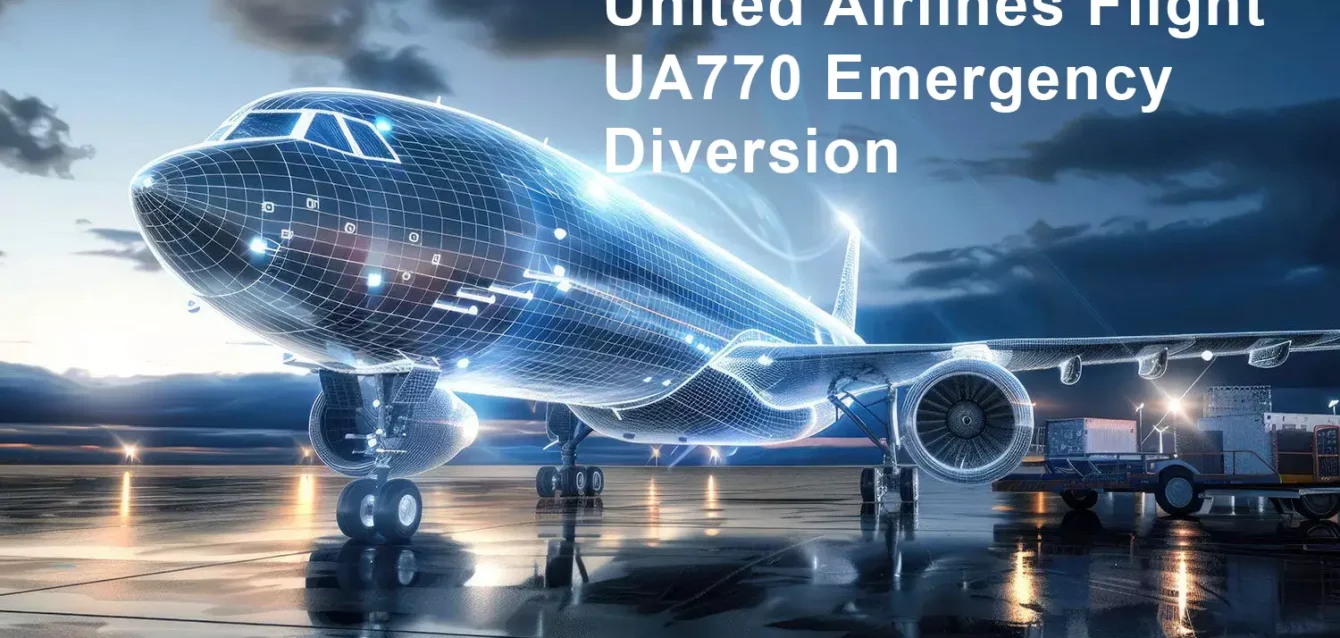United Airlines Flight UA770 Emergency Diversion
Picture this: you’re comfortably seated at 37,000 feet, enjoying your in-flight entertainment, when suddenly the aircraft banks sharply left and the captain’s voice crackles over the intercom: “Ladies and gentlemen, we’re experiencing an unexpected situation that requires an immediate diversion to London.” This is exactly what happened to 289 passengers aboard United Airlines flight UA770 on May 27, 2025.
What started as a regular Barcelona-to-Chicago journey transformed into a gripping real-life drama that showcased both the unpredictability of air travel and the remarkable resilience of human spirit under pressure.
The Emergency Unfolds: Timeline of United Airlines Flight UA770
From Routine to Crisis in Minutes
United Airlines flight UA770 departed Barcelona’s El Prat Airport bound for Chicago O’Hare International Airport on what appeared to be a perfectly normal Tuesday morning. The Boeing 787-9 Dreamliner (registration N26902) carried 289 souls who had no idea their journey would become an extraordinary test of aviation emergency protocols.
Flight Details:
- Route: Barcelona (BCN) → Chicago (ORD)
- Aircraft: Boeing 787-9 Dreamliner
- Passengers: 289 people aboard
- Crew: Experienced United Airlines personnel
The Critical Moment: Emergency Declaration
As the aircraft cruised over European airspace, something went wrong. The flight crew immediately transmitted squawk code 7700 – the universal aviation emergency signal that instantly alerts every air traffic control facility within a 200-mile radius.
What Squawk Code 7700 Really Means
When pilots activate the 7700 emergency code, it triggers a cascade of automated responses:
- All radar systems within 200 nautical miles receive priority alerts
- Air traffic controllers immediately clear priority airspace
- Emergency services at nearby airports begin preparation protocols
- International coordination systems activate automatically
The Decision: Emergency Diversion to London Heathrow
The crew’s decision to divert to London Heathrow wasn’t random. Several factors made Heathrow the optimal choice:
- Strategic location relative to the aircraft’s position
- World-class emergency facilities available 24/7
- Runways capable of handling the Boeing 787-9
- Medical services specialized in aviation emergencies
Inside the Cabin: Passenger Experiences During the Emergency
Initial Reactions: Fear, Confusion, and Hope
The passengers aboard United Airlines flight UA770 emergency diversion experienced a roller coaster of emotions that many described as life-changing.
Jennifer Martinez, traveling with her family: “At first, we just felt the plane turning. Then the captain spoke. His voice was so calm and professional – that’s what kept us from panicking. He explained we were diverting to London as a precautionary measure.”
Robert Chen, business traveler: “I immediately opened my flight tracking app. Seeing our route change toward London made it real. But the crew’s professionalism was incredible – they kept everyone informed and calm.”
The Crew’s Professional Response
The United Airlines cabin crew demonstrated exceptional crisis management:
- Clear communication with frequent updates
- Reassuring presence throughout the aircraft
- Professional demeanor that calmed anxious passengers
- Emergency procedure preparation conducted smoothly
Passenger Support and Unity
What emerged during the crisis was remarkable human solidarity:
- Strangers comforting each other
- Experienced travelers sharing knowledge
- Parents explaining the situation to children
- Crew members providing individual attention when needed
The Technology Behind the Emergency Response
Boeing 787-9 Emergency Systems
The aircraft involved in the United Airlines flight UA770 emergency diversion was equipped with state-of-the-art safety technology:
Advanced Communication Systems
- Dual VHF radios for air traffic control contact
- Satellite communication (SATCOM) for long-range coordination
- ACARS data link for real-time aircraft status transmission
- Emergency locator transmitters with GPS integration
Safety and Navigation Technology
- Fly-by-wire controls with envelope protection
- Multiple redundant systems for critical functions
- Advanced weather radar for route optimization
- Automated emergency descent capability if needed
Real-Time Flight Tracking: Modern Transparency
The emergency was followed live by thousands of people worldwide through platforms like FlightRadar24, demonstrating how modern ADS-B technology provides unprecedented transparency in aviation operations.
ADS-B Technology Benefits:
- Position accuracy within 3 meters
- Updates every second during emergencies
- Real-time tracking available to the public
- Integration with official monitoring systems
United Airlines’ Crisis Management Response
Immediate Corporate Action
United Airlines activated its emergency response protocols the moment flight UA770 declared the emergency:
Rapid Response Measures:
- Emergency operations center activation in Chicago
- Family notification procedures initiated
- Coordination with European aviation authorities
- Replacement crew and aircraft preparation
Passenger Care and Support
The airline implemented comprehensive passenger support:
- Emergency accommodation in London hotels
- Meal vouchers for all affected passengers
- Priority rebooking on next available flights
- 24/7 customer service dedicated hotline
- Baggage assistance and tracking support
Communication Strategy
United Airlines maintained transparent communication:
- Regular updates through official channels
- Social media monitoring and response
- Direct passenger communication via phone and email
- Media statements emphasizing safety priorities
Air Traffic Impact: The Ripple Effect
European Airspace Coordination
Die United Airlines flight UA770 emergency diversion required exceptional coordination across multiple air traffic control centers:
Coordination Challenges:
- Barcelona Control (departure coordination)
- EUROCONTROL (European airspace management)
- London Control (approach vectors)
- Heathrow Tower (final approach and landing)
Impact on Other Flights
The emergency created operational challenges:
- Delayed departures at multiple airports
- Route adjustments for aircraft in the vicinity
- Gate reassignments at destination airports
- Crew scheduling complications across the network
System Resilience
Despite the disruption, the aviation system demonstrated remarkable resilience:
- Minimal passenger impact beyond immediate vicinity
- Rapid recovery of normal operations
- Effective resource reallocation
- Maintained safety standards throughout
Emergency Landing at Heathrow: Precision Under Pressure
Airport Emergency Preparation
London Heathrow’s response showcased world-class emergency preparedness:
Emergency Services Deployment:
- Aircraft Rescue and Firefighting (ARFF) vehicles positioned
- Medical teams on standby within 3 minutes
- Ground support equipment pre-positioned
- Passenger buses ready for immediate deployment
The Landing: Textbook Emergency Response
The actual landing proceeded flawlessly:
- Stable approach despite emergency conditions
- Normal touchdown on Runway 27R
- Controlled rollout within safety parameters
- Immediate safety inspection by ground crews
Post-Landing Procedures
Once safely on the ground:
- Passenger evacuation completed in under 15 minutes
- Aircraft inspection by specialized technicians
- Passenger processing through dedicated facilities
- Baggage handling expedited for quick access
Safety Protocols: Lessons from the Emergency
Training Excellence in Action
The United Airlines flight UA770 emergency diversion highlighted the effectiveness of comprehensive training programs:
Crew Training Standards
- Monthly emergency simulations for all crew members
- Stress management techniques under pressure
- Multi-scenario preparation for various emergency types
- Internationale Koordination protocols
Technologie-Integration
- Automated emergency systems performed flawlessly
- Human-machine coordination optimized for crisis situations
- Real-time data sharing enabled informed decision-making
- Backup systems provided necessary redundancy
Kontinuierlicher Verbesserungsprozess
Every emergency contributes to aviation safety advancement:
- Data analysis of flight parameters and decisions
- Crew performance evaluation for training enhancement
- System effectiveness assessment for future improvements
- International protocol refinement based on real-world experience
Passenger Rights and Compensation
Immediate Support Provided
United Airlines offered comprehensive immediate assistance:
- Free accommodation at London airport hotels
- Meal allowances for extended delays
- Transportation between airport and hotels
- Communication assistance for family notifications
Long-term Compensation Considerations
Passengers may be entitled to various forms of compensation:
- EU Regulation 261 rights for European departures
- Travel insurance coverage for unexpected expenses
- United Airlines goodwill gestures beyond legal requirements
- Miles or credits for future travel
How to Claim Compensation
Affected passengers should:
- Keep all receipts for emergency-related expenses
- Document the experience with photos and notes
- Contact United Airlines customer service promptly
- File insurance claims falls zutreffend
- Seek legal advice if necessary for complex situations
The Human Side: Stories of Resilience
Unexpected Heroes
Die emergency brought out the best in people:
Flight attendant Sarah Williams: “In 15 years of flying, this was my first real emergency. But our training kicked in, and seeing passengers help each other was incredibly moving.”
Passenger Michael Thompson: “There was this elderly couple who seemed really scared. A group of us just naturally started talking to them, sharing stories. By the time we landed, we felt like family.”
Children and Families
Special attention was given to families with children:
- Calm explanations appropriate for young passengers
- Extra comfort items distributed by crew
- Priority assistance during evacuation
- Family seating maintained throughout the process
Business Travelers’ Adaptation
Frequent flyers demonstrated remarkable adaptability:
- Meeting rescheduling via in-flight wifi
- Hotel bookings using mobile apps
- Alternative routing planning during the diversion
- Calm leadership that helped other passengers
Media Coverage and Public Response
Social Media Reaction
The emergency generated significant online attention:
- Live tracking by aviation enthusiasts
- Aktualisierungen in Echtzeit from passengers onboard
- Professional commentary from aviation experts
- Support messages from around the world
Aviation Community Response
Industry professionals praised the handling:
- Pilot associations commended crew professionalism
- Safety experts highlighted system effectiveness
- Airlines shared solidarity with United Airlines
- Regulators noted successful protocol execution
Investigation and Analysis
Official Investigation Process
Aviation authorities initiated standard procedures:
- Flight data recorder Analyse
- Cockpit voice recorder examination
- Maintenance record Überprüfung
- Crew interview Prozess
Preliminary Findings
While the full investigation continues:
- No fault found with crew performance
- Aircraft systems functioned as designed
- Emergency protocols followed correctly
- Coordination between agencies was exemplary
Industry Learning
The incident provides valuable insights:
- Training program validation for emergency scenarios
- Technology effectiveness in real-world conditions
- International cooperation protocol success
- Passenger communication best practices
FAQ: United Airlines Flight UA770 Emergency Diversion
What exactly caused the emergency on UA770?
While the specific technical details haven’t been fully disclosed pending the official investigation, United Airlines confirmed it was a precautionary diversion to ensure passenger and crew safety.
How long did the emergency diversion take?
From the initial emergency declaration to landing at Heathrow, the entire diversion took approximately 45 minutes.
Were any passengers injured during the emergency?
No injuries were reported among the 289 passengers and crew members. The emergency was handled smoothly with professional precision.
What happened to the aircraft after landing?
The Boeing 787-9 underwent comprehensive technical inspection at Heathrow before being cleared to return to service.
How were passengers accommodated after the diversion?
United Airlines provided hotel accommodation, meals, and rebooking on the next available flights to Chicago at no additional cost to passengers.
Can passengers claim compensation for the diversion?
Passengers may be entitled to compensation under various regulations and should contact United Airlines customer service for specific details about their situation.
How can people track flights during emergencies?
Flight tracking websites like FlightRadar24 provide real-time aircraft position data through ADS-B technology, allowing public monitoring of flight progress.
What training do crews receive for such emergencies?
Airlines provide comprehensive emergency training including monthly simulations, stress management techniques, and international coordination protocols.
Conclusion: Aviation Safety Excellence in Action
Die United Airlines flight UA770 emergency diversion of May 27, 2025, stands as a testament to the robustness of modern aviation safety systems and the exceptional professionalism of the people who make air travel the safest form of transportation in the world.
This incident demonstrated several critical success factors:
- Crew training excellence under genuine pressure
- Technology integration that enhances rather than replaces human judgment
- International cooperation that transcends borders in crisis situations
- Passenger resilience and community spirit in challenging circumstances
Looking Forward: Continuous Improvement
Every emergency in aviation contributes to making future flights safer. The lessons learned from UA770 will:
- Enhance training programs with real-world scenarios
- Improve communication protocols between crew and passengers
- Refine emergency procedures based on actual performance
- Strengthen international cooperation Rahmenwerke
The Human Element
While technology played a crucial role in the successful outcome, it was the human elements – crew professionalism, passenger cooperation, and ground support excellence – that truly made the difference. The 289 people aboard United Airlines flight UA770 experienced firsthand how decades of aviation safety improvements create multiple layers of protection.
The aviation industry’s commitment to continuous improvement means that incidents like UA770 don’t just end with safe landings – they become building blocks for an even safer future for the millions of passengers who take to the skies every day.
As investigations conclude and official reports are published, the UA770 emergency will join the extensive database of aviation safety knowledge that helps ensure such professional responses become routine rather than exceptional.
For those who lived through this experience, it was a reminder of both human vulnerability and human excellence. For the aviation industry, it was another successful demonstration that decades of safety investments and training continue to protect lives when they matter most.





